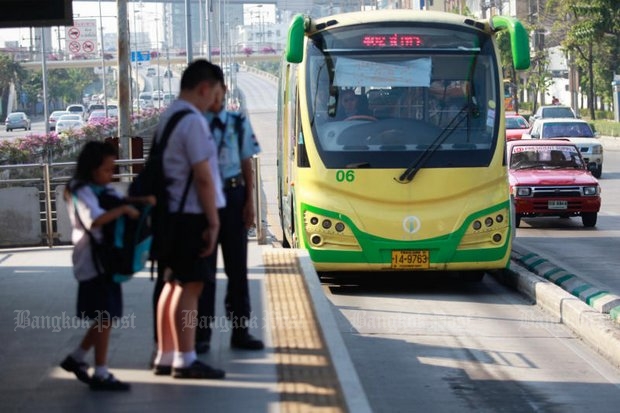
The Bus Rapid Transit (BRT) service is losing money, but the Bangkok Metropolitan Administration (BMA) insists it will press on with it in the hope of easing the city's longstanding traffic problems.
Run by the BMA, the BRT is a feeder service operating between Narathiwat Ratchanakharin Road and Rama III Road linking the Sathon and Ratchapreuk areas.
The buses use a 3.5 kilometre reserved lane on Narathiwat Ratchanakharin Road and a 12.4km High Occupancy Vehicles (HOV) lane on Rama III Road to ensure quicker trips for city commuters.
A source at the BMA said the number of commuters using the service is still not enough to cover costs, even with the agency's attempts to cut fares.
Initially, commuters were charged a flat rate of 10 baht. Fares were then cut by half to urge more commuters to use the service.
The BMA would consider whether to increase the fares again to cover its high operating costs, the source said.
The BMA pays about 200 million baht annually to the Bangkok Mass Transit System Plc, which operates the BTS's skytrain, to run the BRT services, under a seven-year operational contract ending next year, the source said.
But the service generates annual revenue of only 20-30 million baht, the source added.
The BMA will press on with the BRT, however, as the bus serves as an alternative feeder route for commuters in addition to buses, taxis, motorcycle taxis and boats that provide access from the city's main rapid transit systems to smaller roads, the source said. The BMA will not take out any loans from other financial institutions or banks to support the BRT services but it will spend money from its annual budget.
The source also urged city residents to switch from using their cars to public transport to help tackle traffic congestion, adding that increasing numbers of commuters who take public transport would help make the BRT service more cost-effective.
The BRT would be scrapped if the city could find other modes of transport to move people from outer areas to the city, the source said.
The BMA has proposed the construction of the "Grey Line" monorail which will link Watcharapol and Tha Phra via Rama IX, according to the source.
Driver carelessness and lax enforcement of city traffic ordinances are aggravating problems for the service, the source said.
The HOV system is meant to move more people by discouraging single or low-occupancy car use and but many drivers have made no effort to obey the rules and take advantage of the restricted traffic lane at peak travel times, delaying BRT buses, the source said.
The BRT serves about 23,000 commuters per day on average, up to a maximum of 28,000 commuters per day.
The BMA source urged traffic police to take action against violators.
Responding to criticism of police leniency in traffic enforcement, Pol Col Ekkarak Limpsungkat, deputy commander of the Traffic Police Division attached to the Metropolitan Police Bureau, urged the BMA to seek help from traffic police overseeing the bus routes.
He admitted traffic police may allow other vehicles to use reserved bus lanes to make the most of the lanes.
Pol Col Ekkarak insists police must take action against drivers who violate traffic regulations.
A regular BRT user, Parisa Rojanajarukorn, 42, a translator, said she will continue using the bus service even if fares increase.
The bus service provides easy access to her office in the city, while the fare was cheaper than other feeders including motorcycle taxi services. Ms Parisa usually takes the bus from her house on Chan Road to stop at BTS skytrain's Chong Nonsi station to take the train to her office on Silom Road.
Pimpirada Sripan, 50, said she has never used the BRT service as as she usually works late at night when the service is not available. It is not practical, she said, adding the buses take up lanes from other vehicles, making traffic worse.
The BRT was part of former Bangkok governor Apirak Kosayodhin's election campaign for governor in 2005 and was touted as a way to help relieve the city's traffic congestion.
The service was to have begun in 2007 at a cost of 2 billion baht. But the deadline was pushed back twice and after some delays, the project went into service in May 2010 during Sukhumbhand Paribatra's first term as Bangkok governor. The delay was partly caused by a Department of Special Investigation probe into alleged irregularities in the procurement of buses.
Since it was launched in 2010, the service has faced opposition from public transport providers because the bus lane takes up space from other users. Bangkok residents have also criticised the service because it is under-utilised.
